I need help identifying which wire is which inside my USB cable. So I stripped the outer insulator for the USB cable, and it revealed 4 wires: Red, White, Green, and Yellow.
I thought Red would be VCC, but then I checked the circuit board for the mouse I ripped it off of and the board labeled where the four wires were soldered on.
It showed four characters each associated with a wire color: V (White), G (Green), D (Yellow), C (Red). Very strange from what I have learned about USB so far, but strangest being that Red is not VCC! Why is there no standard for these wire colors?
Anyways, how can I confirm which is which (VCC, GND, D-, D+)? I have a multimeter, and confirmed that between White and Green, White and Red, and White and Yellow, there is 5V. I don't think that is much of a development, but what should I do?
I do have other USB cables lying around as well, but that's an easy way out and my absolute last resort. Thanks.
